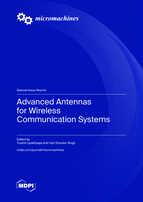Advanced Antennas for Wireless Communication Systems
A special issue of Micromachines (ISSN 2072-666X). This special issue belongs to the section "E:Engineering and Technology".
Deadline for manuscript submissions: closed (30 April 2023) | Viewed by 19126
Special Issue Editors
Interests: planar antennas; metamaterials and metasurfaces; Multiple-Input Multiple-Output (MIMO) systems; satellite antennas; Substrate Integrated Waveguides (SIWs); antenna impedance matching networks; on-chip antennas; terahertz absorbers; microwave filters; interplanetary sciences
Special Issues, Collections and Topics in MDPI journals
Interests: microstrip antenna and their applications; artificial materials & their applications; MIMO antenna systems; mobile antenna; multiple antennas-user interactions; terahertz Absorbers; microwave antennas for biomedical applications
Special Issue Information
Dear Colleagues,
This Special Issue aims to present a collection of innovative scholarly papers that focus on antennas for varied communication system applications. With the rapid rise of technological advances in current wireless communication systems, the demands of users for high-speed internet connections are skyrocketing, since this is the crucial pipeline that interconnects several gadgets. Over several decades, many researches have focused on upgrading existing microwave and radio frequency (RF) components, especially antenna systems, often referred to as the backbone of a wireless system. Advanced communication antenna technology has significantly evolved over several years, improving communication quality in domestic and commercial applications. The present technology has strong constraints regarding the electrical and mechanical size of the antenna design; however, an optimal radiation performance is a strict requirement. The tradeoff between physical antenna parameters and cost-performance is vital for successful antenna design. Moreover, to fulfill the ever-increasing demands of users, the field of radio communication has significantly developed. In every wireless system, an antenna plays a crucial role. It provides access to several applications standards like GSM, UMTS, WLAN, Wi-Fi, 4G, etc. Nowadays, research is turning its attention toward the most exciting novel technologies, such as MIMO, Massive-MIMO, UWB-MIMO, Terahertz antennas, etc. These techniques not only fulfil data rate demands but maintain as low a cost as possible. This Special Issue seeks such designs that incorporate optimal performance parameters.
This Special Issue, entitled “Advanced Antennas for Wireless Communication Systems”, invites papers that encompass the advances and prospects in the antenna design of microwave and millimeter-wave applications.
Prof. Dr. Trushit Upadhyaya
Dr. Hari Shankar Singh
Guest Editors
Manuscript Submission Information
Manuscripts should be submitted online at www.mdpi.com by registering and logging in to this website. Once you are registered, click here to go to the submission form. Manuscripts can be submitted until the deadline. All submissions that pass pre-check are peer-reviewed. Accepted papers will be published continuously in the journal (as soon as accepted) and will be listed together on the special issue website. Research articles, review articles as well as short communications are invited. For planned papers, a title and short abstract (about 100 words) can be sent to the Editorial Office for announcement on this website.
Submitted manuscripts should not have been published previously, nor be under consideration for publication elsewhere (except conference proceedings papers). All manuscripts are thoroughly refereed through a single-blind peer-review process. A guide for authors and other relevant information for submission of manuscripts is available on the Instructions for Authors page. Micromachines is an international peer-reviewed open access monthly journal published by MDPI.
Please visit the Instructions for Authors page before submitting a manuscript. The Article Processing Charge (APC) for publication in this open access journal is 2600 CHF (Swiss Francs). Submitted papers should be well formatted and use good English. Authors may use MDPI's English editing service prior to publication or during author revisions.
Keywords
- planar & surface mountable Antennas
- metamaterials and metasurfaces
- multiple-input multiple-output (MIMO) Antennas
- compact antenna arrays for massive MIMO systems
- satellite communication antennas
- multi-beam Antennas
- substrate-integrated waveguide (SIW) Antennas
- Electromagnetic Bandgap (EBG) structures
- Synthetic Aperture Radar (SAR) Antennas
- Radio Frequency Identification (RFID)
- Near-Field Communication (NFC) Antennas
- millimeter-waves (mm-Waves) and terahertz (THz) Antennas
- electromagnetics devices & systems








